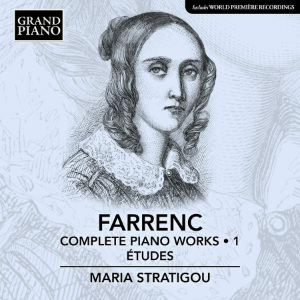
Louise Farrenc (1804-1875) Complete Piano Works Volume 1
Trente Études dans tous les tons majeurs et mineurs Op.26 (1833-38)
Douze Études Brilliantes Op.41 (1853)
Vingt Études de Moyenne Difficulté Op.42 (1854)
Vingt-Cinq Études Faciles Op.50 (pub. 1859-63?)
Maria Stratigou (piano)
rec. 2017-2020, Royal Northern College of Music, Manchester
GRAND PIANO GP912-13 [71 +70]
Louise Farrenc’s first studies were with Cécile Soria, a pupil of Muzio Clementi and she went on to study piano with two giants of the 19th century, Ignaz Moscheles and Johann Nepomuk Hummel as well as taking private lessons in composition from Antonin Reicha. She had a successful career as a pianist and indeed all of her early output is for the instrument, mostly opera paraphrases and variations including the Air Russe Varié op.17 that received praise from Robert Schumann. She branched into orchestral music at the age of thirty and in the 1840s wrote three symphonies which are now attracting attention as well as vocal and chamber works; she won the Prix Chartier for chamber music twice and renowned violinist Joseph Joachim was one of the performers in the premiere of her Nonet op.38. Her fame as a performer was such that in 1842 she became only the second female professor of piano at the Paris Conservatoire and unlike the first, Hélène de Montgeroult, she remained there for thirty years. She stopped composing in 1859 when her daughter Victorine died but continued teaching until the end of her life.
Dr. Maria Stratigou studied in Athens, Scotland and at Manchester’s Royal Northern College of Music where she completed her PhD, Performance Aspects of Louise Farrenc’s Piano Études. This two-disc set is marked complete piano works volume 1 and brings together her complete études from the huge set of thirty that became compulsory study for students at the Paris Conservatoire and was also used at the conservatoires in Brussels and Bologna, to the brilliant etudes written a decade into her time at the Conservatoire and the somewhat easier set that was probably amongst her last compositions. None of these are concert études like the grand tone poems that Liszt wrote or the études of Chopin that raised the humble study into high art but neither are they mere didactic pieces; Farrenc played a selection in her recitals in 1838 and many would grace a recital even today. Fiercely difficult they offer a wide variety of styles and challenges from the fiery opener, perhaps the most traditionally etude like trading rising and descending broken chords between the hands, through the quicksilver tarantelle that is number eleven, the epic eighth study in trills that keeps both hands busy, the finger-twisting seventeenth and utterly devilish F minor, the twenty-second. Equally impressive are the slower items, especially the impassioned F sharp minor (number ten) with its Chopinesque decoration and the twenty-first in A flat whose melody attracts a gradually more complex accompaniment much like the slow movement of Beethoven’s C minor Sonata op.13. In the spirit of teaching there are three fugues but these are not the only nods to baroque music; two canons and a minuet have echoes of Bach and the fourteenth is a tricky homage to Scarlatti. Mendelssohn is the closest inspiration, even more so in the later sets of études but I could also hear Moscheles reflected in the jaunty third and twenty-eighth both of which put me in mind of the Terpsichore étude from her teacher’s op.95 études. It is clear that composers such as Benjamin Godard, Cécile Chaminade and Moriz Moszkowski were familiar with these pieces; I could hear the G minor étude from Moszkowski’s Études de Virtuosité in the fifth of the set and the figuration of en Automne in the seventeenth étude.
The next two sets, the études brilliantes and études of medium difficulty, written in the 1850s, are in much the same vein especially the op.41 set. Once again there is some highly enjoyable music here; the whirling études in D minor and C minor (numbers 3 and 8), the very demanding octave étude, number 10 and the dancing étude in F, number 11, which shares triplets between the hands, sounding like some over excited Schubert song accompaniment. The difficulties ease somewhat in the op.42 set as the of medium difficulty subtitle suggests though nimble fingers are still the order of the day if one wants to tackle the spinning notes of the sixth, the moto perpetuo ninth or toccata like tenth. Mendelssohn’s spirit is close in the stately andante eleventh and Weber in the sparkling figuration of the sixteenth but again these are fleeting glimpses. Most of these are shorter pieces than in the previous sets as are the études in her final collection, Vingt-Cinq Études Faciles; each étude here has its purpose stated at the beginning such as precision in 6/8 tempo, playing a waltz in which one must play in a graceful manner or to alternate equally two by two with each hand. The title page bears the dedication a mes petites éleves and I imagine that many an amateur would have delighted in these melodic and imaginative pieces that don’t share the daunting technical challenges of her previous sets. I am reminded of Mendelssohn’s song without words in some of these; Farrenc captures the melodic style marvellously and certainly études like the lyrical fourth or lilting twenty fourth would fit right in alongside them.
I am very impressed with Maria Stratigou’s playing here. Technically she is absolutely on top of these études but she has the lyrical expertise to bring out the necessary lightness of touch and shading even in the most exacting moments; her delicacy in the figuration of op.26 no.10 is delicious. I hope she is the pianist who will continue this valuable and enjoyable series.
Rob Challinor
Help us financially by purchasing from





















